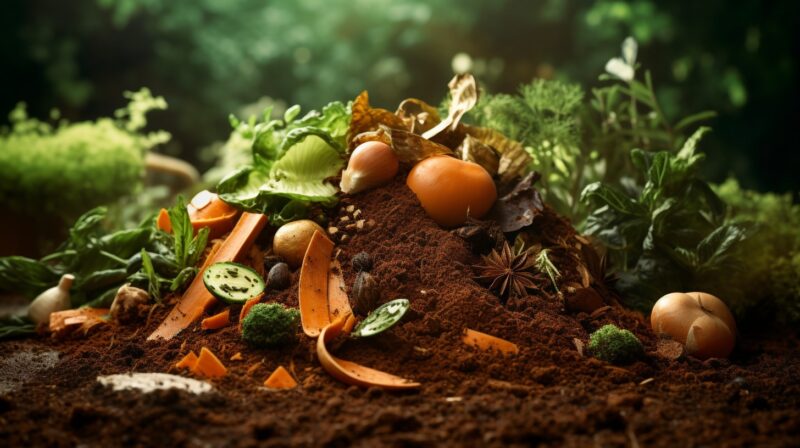Hi there! I’m someone who invested years into learning all there is to know about organic composting. I’ve gained a wealth of knowledge about turning everyday waste into valuable, nutrient-rich compost.
I know just how challenging this task can be for those who do not have the necessary knowledge and lack experience. Therefore, my goal is to provide clear, practical advice that makes composting straightforward and rewarding. Using the best tumblers the market has to offer might be quite convenient in this case.
That is why I am hoping this guide is designed to equip you with the skills and understanding needed to successfully create and maintain your compost system.
Getting Started with Composting
Composting is an environmentally friendly practice that transforms kitchen and garden waste into nutrient-rich soil. It’s a simple and effective way to reduce waste and enhance the health of your garden.
The first thing you should be aware of is different types of composting.
| Method | Description |
|---|---|
| Onsite Composting | Refers to composting done at the site where the waste is generated, such as in home gardens or community centers. |
| Vermicomposting | Uses worms, usually red wigglers, to decompose organic waste. Ideal for indoor composting and produces nutrient-rich castings. |
| Aerated (Turned) Windrow Composting | Large piles of compostable materials are periodically turned to introduce oxygen, speeding up the decomposition process. |
| Aerated Static Pile Composting | Compost materials are formed into piles and aerated with blowers or a system of pipes, reducing the need for turning. |
| In-Vessel Composting | Organic materials are composted within a closed container, allowing for greater control over environmental conditions. |
After you learn this, it’s important to understand the basics, from selecting the right location and container to balancing the materials in your compost pile.
| Aspect | Details |
|---|---|
| Location and Container | – Location: Near kitchen/garden, with good drainage and partial shade. – Compost Bin Types: Choose based on garden size and waste amount; options range from simple bins to tumblers. |
| Composting Materials | – Greens: Nitrogen-rich, e.g., food scraps, coffee grounds. – Browns: Carbon-rich, e.g., dry leaves, straw. – Balance: Aim for a 2:1 ratio of browns to greens. |
| Materials to Avoid | Avoid meat, dairy, diseased plants, and chemically treated items. |
| Building the Compost Pile | – Layering: Start with coarse material, then alternate greens and browns. – Size: Aim for a 3 feet high and wide pile. – Moisture and Aeration: Keep moist and turn regularly. |
| Monitoring and Maintenance | – Observation: Check for moisture and temperature. – Adjustments: Add water or greens if dry; add browns and turn if too wet. |
| Final Stages | Compost is ready when it is dark, crumbly, and has an earthy smell, typically after a few months to a year. |
However, we will discuss all these steps later in the article.
What is Composting and Why is it Important?
We are talking about a natural process of recycling organic matter, such as leaves, vegetable scraps, and garden trimmings, into a valuable soil amendment known as compost. This process is facilitated by microorganisms, such as bacteria and fungi, along with larger organisms like worms and insects.
The benefits of composting are manifold. It enriches the soil, helping retain moisture and suppress plant diseases and pests. It reduces the need for chemical fertilizers, encouraging the production of beneficial bacteria and fungi that break down organic matter to create nutrient-rich material.
Moreover, composting reduces methane emissions from landfills and lowers your carbon footprint.
Reduces Waste and Improves Soil Health
Composting plays a significant role in waste reduction. By composting, you can divert as much as 30% of household waste away from the garbage can. This not only eases the burden on landfills but also reduces greenhouse gas emissions.
In terms of soil health, compost acts as a natural fertilizer, adding essential nutrients back into the soil. It improves soil structure, porosity, and density, thus creating a better plant root environment.
Increased organic matter in the soil enhances its ability to hold water and reduces erosion. By improving soil health, composting also supports biodiversity in the soil ecosystem.
Making Your Compost Pile
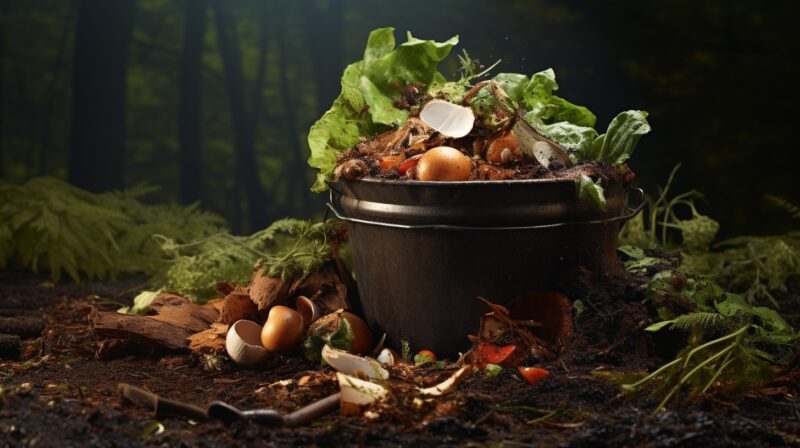
Embarking on the creation of your compost pile is an exciting step towards sustainable living. Let’s delve into the specifics of how to effectively build and maintain your compost pile.
Location and Container
Selecting the right location and container for your compost pile is crucial. Ideally, choose a spot in your yard that is easily accessible yet out of the way of daily activities.
It should be a flat area with good drainage to prevent waterlogging, and partial shade is preferable to protect the pile from drying out in direct sunlight or getting too wet in heavy rains. As for the container, there are several options depending on your space and needs.
A simple heap works if you have ample space, but enclosed bins are great for smaller gardens and help deter pests. Tumblers are another popular choice, especially for urban composters, as they are compact and make turning the compost effortless.
The size of your container should reflect the amount of organic waste you anticipate generating; a typical household might need a bin that’s about 1 cubic meter in size.
Layering Greens, Browns, Water, and Air
Think of your compost pile like a carefully crafted layered cake, each layer playing a crucial role in the composting process. Begin with a layer of brown materials at the bottom. These can include dry leaves, straw, or shredded paper, and they’re essential for creating a foundation that promotes air circulation.
Next, add a layer of green materials, such as kitchen scraps, grass clippings, or coffee grounds. These materials are rich in nitrogen and are the driving force behind the composting process.
After your green layer, add a thin layer of soil or finished compost. This layer is teeming with microorganisms that jump-start the decomposition process. Continue layering browns and greens, aiming for a balance that will support the composting process.
A good rule of thumb is to have more brown than green material, as this helps maintain the necessary carbon-to-nitrogen ratio.
The size of your compost pile is a critical factor. Ideally, aim for a pile that’s at least 3 feet high and wide. This size is significant because it allows the pile to retain enough heat, which is a key element in speeding up the composting process.
Regular turning of the pile, about once a week, is recommended to ensure proper air circulation and to distribute moisture and heat throughout the pile.
Moisture is another vital component. Your compost pile should be moist, like a wrung-out sponge, but not overly wet. If the pile is too dry, the microbial activity slows down, hindering decomposition. Conversely, if it’s too wet, the pile can become anaerobic, leading to unpleasant odors.
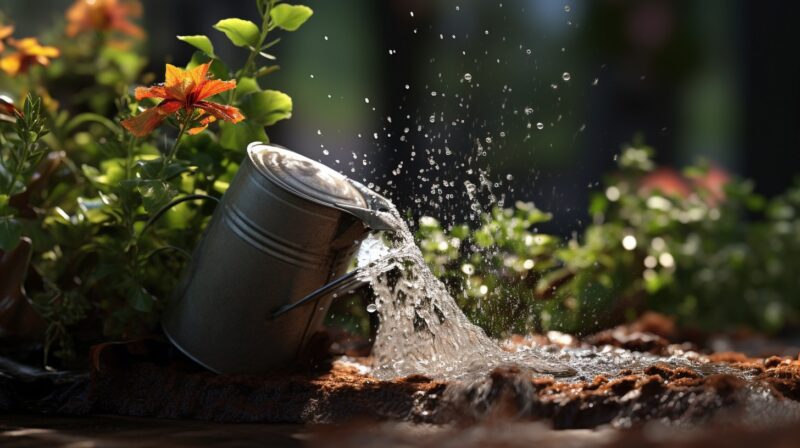
Materials to Avoid
It’s important to be mindful of what you add to it. While many organic materials are compostable, some should be avoided to ensure a healthy composting process and a quality end product.
| Material | Reason to Avoid |
|---|---|
| Meat, Fish, Dairy | Can attract pests and produce unpleasant odors. |
| Diseased Plants | Can transfer diseases to the compost and subsequently to your garden. |
| Weeds that have gone to seed | Seeds can survive the composting process and sprout in your garden. |
| Pet Wastes | Can contain harmful pathogens. |
| Citrus Peels and Onions (in large quantities) | Too acidic and may hinder the activity of composting microbes. |
| Glossy/Colored Paper | Inks and coatings can introduce toxins into your compost. |
Maintaining Proper Moisture and Temperature
Balancing moisture and temperature is the essence of successful composting. Regularly turning your compost pile is crucial in maintaining this balance. It helps evenly distribute moisture and heat, ensuring that all parts of the pile are decomposing effectively.
As the organic materials in your pile break down, they generate heat, often reaching temperatures between 130-160°F. This heat is beneficial as it accelerates the composting process and helps kill off weed seeds and harmful pathogens.
Monitoring the temperature with a compost thermometer can be incredibly useful. It allows you to check if your pile is operating at optimal conditions. If you find that your pile is too cool, consider adding more green materials, which can help raise the temperature.
Alternatively, if the pile is too dry, adding water can help increase the heat.
Using Compost in Your Garden
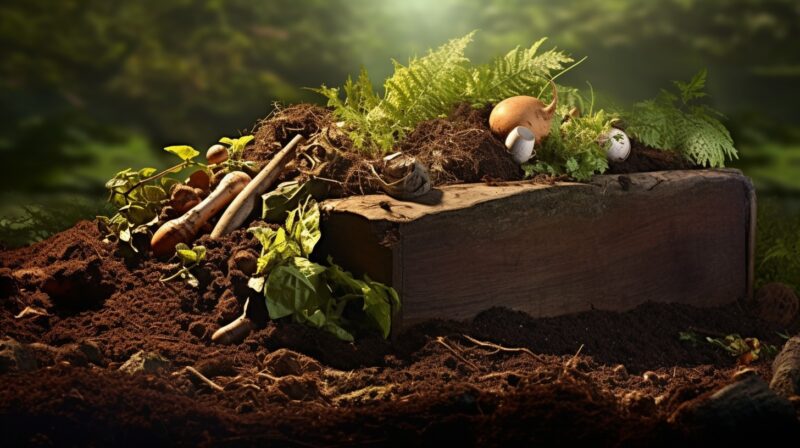
Knowing when your compost is ready to use is key. Finished compost is dark, crumbly, and has an earthy smell. It usually takes anywhere from three to six months to fully mature, depending on factors like the size of the materials, the balance of ingredients, and how often the pile is turned.
To harvest, stop adding new materials a few weeks in advance. Then, sift through the compost, separating any unfinished materials, which can be returned to a new compost pile. Use a screen to filter out larger pieces if desired. The finished compost should be stored in a dry, covered area until you’re ready to use it.
Amending Garden Beds and Enriching Soil
Compost is a versatile material that can be used in various ways in the garden. It can be mixed into the soil at the beginning of the planting season to improve soil structure and nutrient content. This helps in water retention and provides a healthy environment for root growth.
Compost can also be used as a top dressing for established plants or as a component in potting mixes. When used as mulch, it suppresses weeds and retains soil moisture.
Remember, compost is rich in nutrients, but it’s not a complete fertilizer. It works best when used in conjunction with other organic or inorganic fertilizers to meet specific plant needs.
Reaping the Rewards of Home Composting
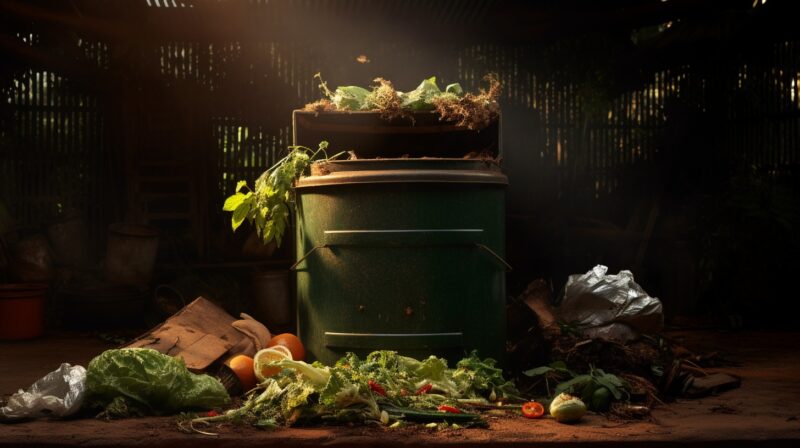
Now it is the time to address the rewards of home composting.
Enjoying Free, Organic Fertilizer
One of the most satisfying aspects of composting is the creation of a rich, organic fertilizer at no extra cost. This homemade compost is free from the chemicals found in many commercial fertilizers and is a sustainable way to nourish your garden.
It’s a full-circle approach to gardening: your kitchen and garden waste is transformed into a valuable resource that, in turn, feeds your plants. This not only saves money but also reduces your environmental footprint by minimizing waste and the need for chemical fertilizers.
Closing the Loop on Household Waste
Composting is a practical example of a closed-loop system, where waste products are recycled back into resources. By composting, you’re taking responsibility for the waste you generate, turning it into something beneficial.
This practice fosters a deeper connection with the environment and promotes sustainable living. It’s a tangible way to contribute to soil health and the larger ecosystem.
Moreover, engaging in composting can be a rewarding educational experience, offering insights into the natural processes of decomposition and nutrient cycling.
Troubleshooting Common Composting Problems
Finally, let us address common issues and how you can solve them.
- Bad Smells:
- Causes: Bad smells typically indicate an imbalance in your compost pile. A rotten smell suggests excessive moisture or insufficient air circulation. It is quite often in the case of compost toilets, but you know potential cons, you can resolve it easily.
- Solutions: Improve aeration by turning the pile. Incorporate ‘browns’ (carbon-rich materials) to absorb excess moisture. If the compost emits an ammonia smell, it’s likely due to a high concentration of ‘greens’ (nitrogen-rich materials). Add more browns to rectify this imbalance.
- Pest Infestations:
- Causes: Rodents and flies are often attracted to compost piles containing exposed food scraps, especially meat and dairy products.
- Solutions: Ensure kitchen scraps are well buried within the pile. Maintain a balanced mix of greens and browns to discourage pests. Consider using a compost bin or a tumbler with a lid or placing wire mesh at the bottom to deter animals.
- Carbon-Nitrogen (C:N) Ratio:
- Importance: The C:N ratio is vital for effective composting. Browns contribute carbon, while greens provide nitrogen. An imbalance can slow down the composting process or cause unpleasant odors.
- Ideal Ratio: Aim for a C:N ratio of approximately 30:1. However, for simplicity, you can target a mix of 2 parts browns to 1 part greens by volume.
- Adjusting the Ratio: If composting is slow, add more greens. If the compost is overly smelly or wet, increase the quantity of browns. Regularly turn the pile and maintain appropriate moisture levels to keep this balance.
- General Tips:
- Regular Monitoring: Regularly check your compost for signs of imbalances and adjust as needed.
- Aeration: Turning the compost pile periodically ensures adequate oxygenation, crucial for the composting process.
- Moisture Control: The compost should be moist but not wet. If it’s too dry, add water or greens; if too wet, add browns.
- Layering: Layering greens and browns can help maintain balance and expedite the composting process.
- Avoiding Certain Materials: Avoid adding meat, dairy, and oily foods to the compost as they can attract pests and create odors.
FAQs
What is a good compost accelerator?
A good compost accelerator is a substance that speeds up the decomposition process in a compost pile. Common accelerators include well-rotted manure, garden soil rich in microorganisms, compost starters available in garden stores, and even everyday items like coffee grounds.
How long does it take for a compost pile to finish?
The time it takes for a compost pile to finish can vary widely depending on factors like the balance of materials, the size of the pile, environmental conditions, and how often the pile is turned. Generally, it can take anywhere from 3 to 6 months for a compost pile to fully decompose and turn into usable compost.
What should you not compost?
Avoid composting meat, dairy products, oily foods, diseased plants, and anything treated with pesticides or chemicals. These can attract pests, cause odors, and potentially harm the composting process.
What is the easiest way to compost?
The easiest way to compost for beginners is using a compost tumbler or a closed bin. These containers simplify the process by containing odors and pests, and they often make turning the compost easier, which is key for aeration and speeding up the composting process.
Closing Thoughts
I hope you feel equipped and inspired to start your own composting practice. Through this guide, I’ve aimed to provide you with the essential knowledge and tips from my own experiences in organic composting.
By adopting composting, you contribute to a healthier environment and play a part in a larger ecological effort. I encourage you to apply what you’ve learned, adapt techniques to your situation, and share your successes and challenges with others.
Let’s make a positive impact together, one compost pile at a time.
Related Posts:
- Advantages & Disadvantages of Composting Toilets:…
- Water Conservation 101: Practical Eco-Friendly…
- Best 13 Composting Toilets For Tiny Houses in 2024
- How Do Red Foxes Survive Winter? Survival Guide
- Rio Dipladenia Care Guide: Best Practices for a…
- How to Reduce Your Pool's Environmental Impact - 2024 Guide


